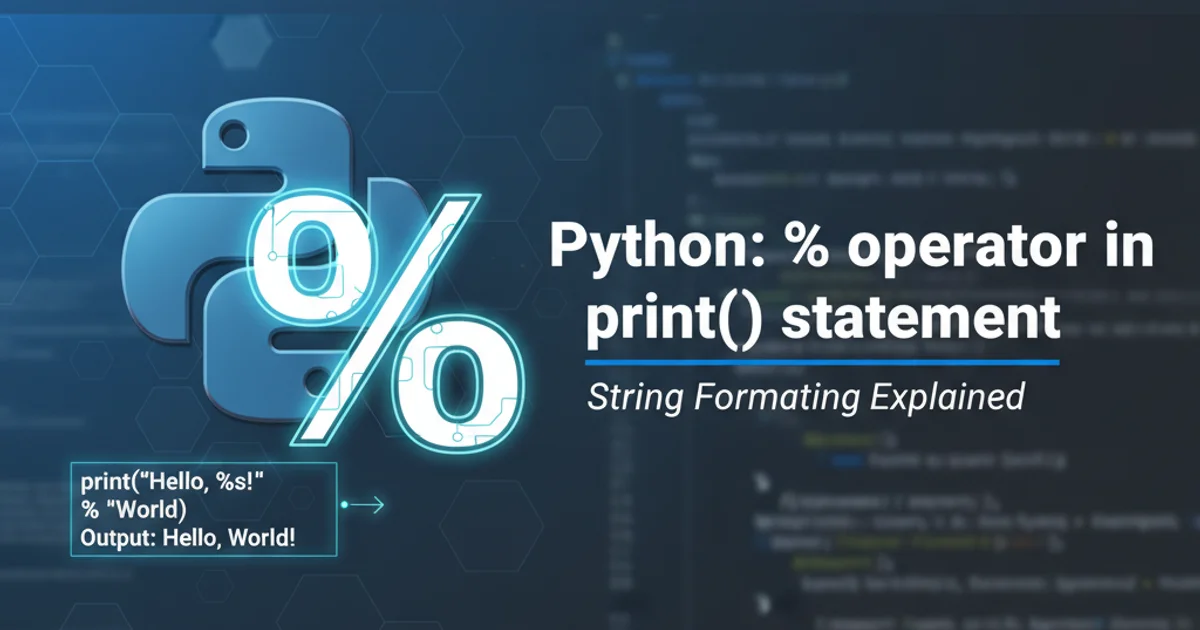Python: % operator in print() statement
Categories:
Understanding Python's % Operator in print() Statements

Explore the historical and practical uses of the modulo operator (%) for string formatting within Python's print() function, and learn why f-strings are now the preferred method.
The % operator in Python, commonly known as the modulo operator, has a dual purpose. While its primary arithmetic function is to return the remainder of a division, it also historically served as a powerful tool for string formatting, particularly within print() statements. This article delves into how the % operator was used for string formatting, its various format specifiers, and why modern Python development has largely moved towards more readable and flexible alternatives like f-strings.
The Modulo Operator for String Formatting
In older versions of Python (prior to Python 3.6), the % operator was the primary mechanism for formatting strings, similar to sprintf in C. It allowed developers to embed values into a string template using special format specifiers. When used with a string, the % operator takes a tuple or dictionary of values and substitutes them into the string based on these specifiers.
name = "Alice"
age = 30
# Using % for string formatting
print("Hello, my name is %s and I am %d years old." % (name, age))
# Formatting a float with precision
pi = 3.1415926535
print("The value of pi is approximately %.2f." % pi)
# Using a dictionary for named placeholders
data = {'city': 'New York', 'temp': 25.5}
print("It's %(temp).1f degrees Celsius in %(city)s." % data)
Examples of using the % operator for various string formatting scenarios.
flowchart TD
A[Start print() statement] --> B{"String with % specifiers"}
B --> C{"Values (tuple/dict)"}
C --> D[Python Interpreter]
D --> E{"Matches specifiers to values"}
E --> F[Substitutes values]
F --> G[Prints formatted string]
G --> H[End]Flowchart illustrating how the % operator processes string formatting.
Common Format Specifiers
The % operator relies on various format specifiers to determine how different data types should be represented within the string. Understanding these specifiers is crucial for correctly formatting output. Here are some of the most commonly used ones:
%s: String (or any object converted to string usingstr())%d: Signed integer decimal%f: Floating point decimal%.nf: Floating point decimal withndigits after the decimal point%x/%X: Hexadecimal integer (lowercase/uppercase)%o: Octal integer%r: String (or any object converted to string usingrepr())
These specifiers can also include flags for alignment, padding, and sign, offering fine-grained control over the output.
% formatting is still functional, it's generally recommended to use f-strings (formatted string literals) for new Python code due to their improved readability and performance. F-strings were introduced in Python 3.6.Transitioning to Modern String Formatting
With the introduction of f-strings in Python 3.6, the % operator for string formatting has largely been superseded. F-strings offer a more concise, readable, and often faster way to embed expressions inside string literals. They allow direct embedding of Python expressions within curly braces {} inside a string literal prefixed with f or F.
name = "Bob"
score = 95.789
# Using f-strings for string formatting
print(f"Player {name} scored {score:.1f} points.")
# F-strings with expressions
width = 10
height = 5
print(f"The area is {width * height} square units.")
Modern string formatting using f-strings, demonstrating improved readability.
Although the % operator for string formatting is considered a legacy feature, understanding its mechanics is valuable, especially when working with older Python codebases or when encountering it in documentation. For new development, embracing f-strings will lead to cleaner and more maintainable code.